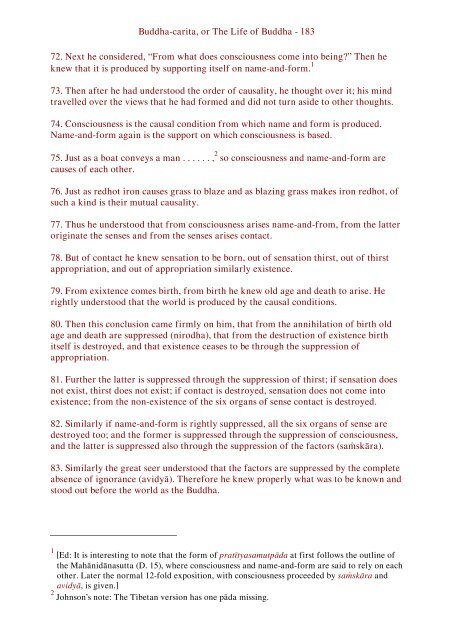The Buddha-Carita or The Life of Buddha by Ven. Aśvaghoṣa
A Sanskrit and English line by line (interlinear) version of one of the most important and influential biographies of the Buddha (together with extensive annotation).
A Sanskrit and English line by line (interlinear) version of one of the most important and influential biographies of the Buddha (together with extensive annotation).
You also want an ePaper? Increase the reach of your titles
YUMPU automatically turns print PDFs into web optimized ePapers that Google loves.
<strong>Buddha</strong>-carita, <strong>or</strong> <strong>The</strong> <strong>Life</strong> <strong>of</strong> <strong>Buddha</strong> - 183<br />
72. Next he considered, “From what does consciousness come into being?” <strong>The</strong>n he<br />
knew that it is produced <strong>by</strong> supp<strong>or</strong>ting itself on name-and-f<strong>or</strong>m. 1<br />
73. <strong>The</strong>n after he had understood the <strong>or</strong>der <strong>of</strong> causality, he thought over it; his mind<br />
travelled over the views that he had f<strong>or</strong>med and did not turn aside to other thoughts.<br />
74. Consciousness is the causal condition from which name and f<strong>or</strong>m is produced.<br />
Name-and-f<strong>or</strong>m again is the supp<strong>or</strong>t on which consciousness is based.<br />
75. Just as a boat conveys a man . . . . . . , 2 so consciousness and name-and-f<strong>or</strong>m are<br />
causes <strong>of</strong> each other.<br />
76. Just as redhot iron causes grass to blaze and as blazing grass makes iron redhot, <strong>of</strong><br />
such a kind is their mutual causality.<br />
77. Thus he understood that from consciousness arises name-and-from, from the latter<br />
<strong>or</strong>iginate the senses and from the senses arises contact.<br />
78. But <strong>of</strong> contact he knew sensation to be b<strong>or</strong>n, out <strong>of</strong> sensation thirst, out <strong>of</strong> thirst<br />
appropriation, and out <strong>of</strong> appropriation similarly existence.<br />
79. From exixtence comes birth, from birth he knew old age and death to arise. He<br />
rightly understood that the w<strong>or</strong>ld is produced <strong>by</strong> the causal conditions.<br />
80. <strong>The</strong>n this conclusion came firmly on him, that from the annihilation <strong>of</strong> birth old<br />
age and death are suppressed (nirodha), that from the destruction <strong>of</strong> existence birth<br />
itself is destroyed, and that existence ceases to be through the suppression <strong>of</strong><br />
appropriation.<br />
81. Further the latter is suppressed through the suppression <strong>of</strong> thirst; if sensation does<br />
not exist, thirst does not exist; if contact is destroyed, sensation does not come into<br />
existence; from the non-existence <strong>of</strong> the six <strong>or</strong>gans <strong>of</strong> sense contact is destroyed.<br />
82. Similarly if name-and-f<strong>or</strong>m is rightly suppressed, all the six <strong>or</strong>gans <strong>of</strong> sense are<br />
destroyed too; and the f<strong>or</strong>mer is suppressed through the suppression <strong>of</strong> consciousness,<br />
and the latter is suppressed also through the suppression <strong>of</strong> the fact<strong>or</strong>s (saskāra).<br />
83. Similarly the great seer understood that the fact<strong>or</strong>s are suppressed <strong>by</strong> the complete<br />
absence <strong>of</strong> ign<strong>or</strong>ance (avidyā). <strong>The</strong>ref<strong>or</strong>e he knew properly what was to be known and<br />
stood out bef<strong>or</strong>e the w<strong>or</strong>ld as the <strong>Buddha</strong>.<br />
1 [Ed: It is interesting to note that the f<strong>or</strong>m <strong>of</strong> pratītyasamutpāda at first follows the outline <strong>of</strong><br />
the Mahānidānasutta (D. 15), where consciousness and name-and-f<strong>or</strong>m are said to rely on each<br />
other. Later the n<strong>or</strong>mal 12-fold exposition, with consciousness proceeded <strong>by</strong> saskāra and<br />
avidyā, is given.]<br />
2 Johnson’s note: <strong>The</strong> Tibetan version has one pāda missing.


















